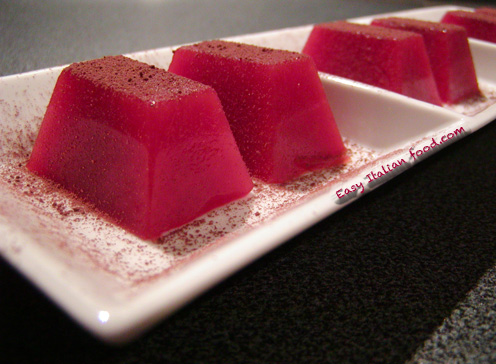
Orange Jelly is a refreshing and vibrant dessert made primarily from freshly squeezed orange juice, sugar, and gelatin. It has a smooth, wobbly texture and a bright citrus flavor that strikes a perfect balance between sweet and tangy. The jelly’s translucent, golden-orange appearance makes it visually appealing, and it often has a clean, light taste, making it an ideal dessert to cleanse the palate after a rich meal.
| 14 pcs | 10min | Easy |
|---|---|---|
Ingredients
- 1 dl. Orange juice
- Sugar to taste
- 2 gr. of Agar agar (Here how to use it)
Method
- Bring the orange juice to a boil.
Add sugar to taste and stir until dissolved.
Add the agar-agar and let it boil for another 15-20 seconds.
Pour the mixture into molds of your choice and allow it to cool completely.
Notes
Agar, also known as agar-agar, is a gelatinous substance derived from red algae. Traditionally, and still today, it is widely used as an ingredient in desserts across Asia. Over the past century, agar has also become essential in microbiology as a solid substrate for culture media. The gelling agent is an unbranched polysaccharide extracted from the cell walls of various red algae species, primarily from the genera Gelidium and Gracilaria, or seaweed such as Sphaerococcus euchema. Commercially, it is most often derived from Gelidium amansii.
Agar can be used as a laxative, a vegetarian alternative to gelatin, a thickener for soups, in jellies, ice creams, and other desserts, as a clarifying agent in brewing, and for sizing paper and fabrics. Chemically, agar is a polymer composed of sugar subunits called galactose. These polysaccharides provide essential structural support to the algae’s cell walls.
Agar-agar is a natural, plant-based counterpart to animal-derived gelatin. It is white and semi-translucent, and is available in both powdered form and as dried strips. It is commonly used to make jellies, puddings, and custards. To prepare jelly, agar-agar is boiled in water until it fully dissolves, after which sweeteners, flavorings, colorings, fruit, or vegetables can be added. The liquid is then poured into molds and allowed to set, resulting in desserts, vegetable aspics, or jelly layers for cakes.